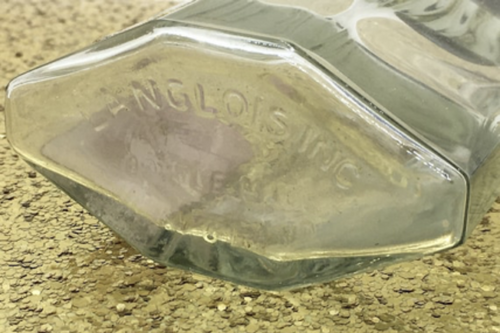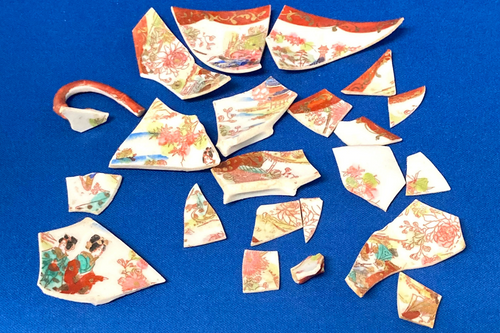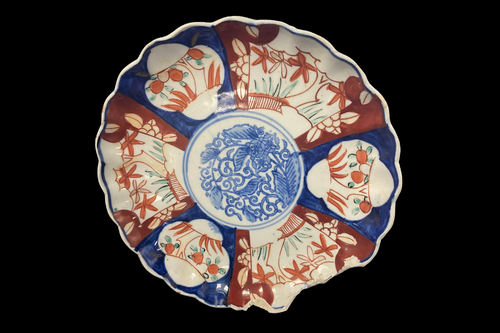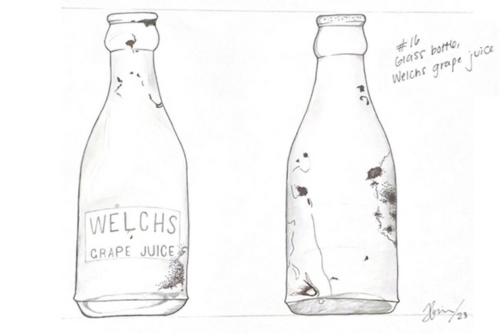
San Diego’s Chinatown
Collections Curiosities is a blog highlighting intriguing artifacts, books, and archival materials that staff, volunteers, and interns have discovered in Center collections and the Center Library. In this blog post, SDAC Volunteer James Sinclair explores a collection recovered from San Diego’s Chinatown.
San Diego’s Chinatown
Blog post and artifact drawings by SDAC Volunteer James Sinclair
Edited by Collections & Library Technician Suzanne Moramarco
San Diego’s Chinatown was an eight-block district inhabited by Chinese immigrants beginning around the 1860s. Located between Market and J, from 6th to 2nd Ave, it was home to men who were fisherman, herbalists, cooks, gardeners, and merchants. Their jobs became limited after the Page Law and Chinese Exclusion Act (1875 and 1882, respectively), as did their housing, property, and citizenship rights. After World War II, Asian-Americans moved to other areas of California. Although there is no significant Chinatown today, the history of the district is preserved by the San Diego Chinese Historical Museum and the San Diego Chinese Center buildings.
Growing up in the San Diego education system, we learn a lot about the Spanish colonizers that settled here and built their missions, or about the Indigenous Kumeyaay that lived on this land long before any of us arrived. There is rich history there, but we don’t learn about local communities outside of where our classmates live. I never knew San Diego was once home to a thriving Chinatown, or about the history that came with it. Through curating this collection, I have been able to connect a part of San Diego’s history to the rest of my knowledge of my hometown, and I have been able to learn a lot about the community that once thrived Downtown.
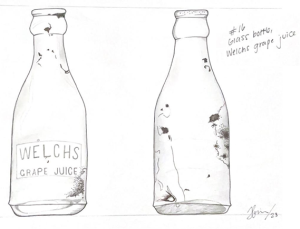
This collection contained many intact and fragmented glass or ceramic bottles, most of them for water, beer, or soda. One that caught my eye was actually a small Welch’s Grape Juice bottle, no more than five or six inches tall. Thanks to the memoir of prominent resident Tom Hom, we know of at least two stores within Chinatown that sold grocery goods: the Wo On store and the Woo Chee Chong Co. The existence of this bottle and the fact that the nearest distributor for Welch’s at the time was in Massachusetts indicates that the grocery stores received shipped goods.
This artifact was a bit of a challenge to draw since the neck had been blown unevenly. However, it was fun to illustrate the flecks of dirt and air bubbles trapped at the bottom of the bottle. This was illustrated with a #2 mechanical pencil, ruler, and various colors and sizes of Pigma Micron opens.
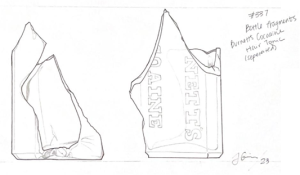
The next artifact that stood out to me was a fragmented bottle, two fragments to be exact. This was a bottle of hair tonic from the 1890s marketed as Burnett’s Hair Cocoaine. The brand Burnett’s sold hair products to prevent dandruff and baldness and to promote “lustrous” hair. Only about half of the bottle was recovered, but it was one of about a dozen cosmetic or toiletry artifacts in this collection. One of them is a perfume atomizer and another a nearly empty ceramic jar with remnants of what looks like lipstick. These artifacts not only show that, once again, the community of Chinatown had access to commercial goods, but it tells us that there were female residents of Chinatown.
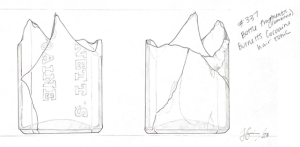
By the 1880 census, there were only eight women in Chinatown, due to laws and restrictions put in place by the Page Law when it was passed in 1875. Further restrictions were applied after the Chinese Exclusion Act of 1882, which stated only privileged Chinese women, the daughters and wives of merchants, could immigrate. The number of Chinese women did begin to increase as prostitution decreased and as women married merchants, grocers, and restaurant owners.
These two illustrations took the most time by far. However, I really enjoyed getting to draw all the small details like the cracks and shadows. These were also both illustrated with a #2 pencil, ruler, and Pigma Micron pens.
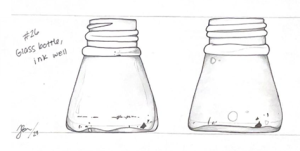
The last two artifacts that caught my attention were a glass inkwell bottle and a ceramic dish, most likely a dipping sauce dish. The first interested me for the reason that it showed a level of literacy in the community. At a time when twenty percent of the entire adult population in the United States was illiterate, and inkwells were still a common writing accessory, the appearance of one tells us that at least the owner of this inkwell was literate.
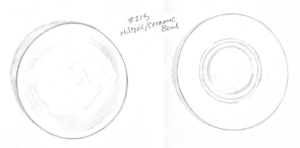
The second artifact, a small ceramic dish, interested me for the reason that it is such a small and common household item that it probably wouldn’t seem important to many. However, I own an exceptionally similar dish to this one, down to the cracks in the enamel, and I know it is a staple in many households. It is mainly for this reason I believe this was used as a dish for sauces like soy sauce or dipping sauce. It also makes me feel connected to the history of San Diego; all of these generations have passed but the people are still the same.
Both of these were illustrated with #2 pencils. The first was further illustrated with Pigma Micron pens. However, I left the ceramic dish without ink to preserve the shadows that make it look three-dimensional and not like a flat circle.
Learn More
If you would like to learn more about San Diego’s Chinatown and possibly see some of these artifacts in person, visit the San Diego Chinese Historical Museum and the San Diego Archaeological Center. You can also read “Rabbit on a Bumpy Road”, a memoir by Tom Hom mentioned earlier in this blog post, or take a virtual walking tour of the district.


